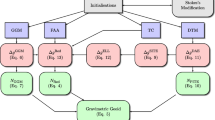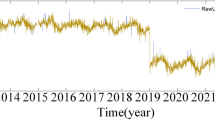Abstract
In this paper we discuss a fast Bayesian extension to kriging algorithms which has been used successfully for fast, automatic mapping in emergency conditions in the Spatial Interpolation Comparison 2004 (SIC2004) exercise. The application of kriging to automatic mapping raises several issues such as robustness, scalability, speed and parameter estimation. Various ad-hoc solutions have been proposed and used extensively but they lack a sound theoretical basis. In this paper we show how observations can be projected onto a representative subset of the data, without losing significant information. This allows the complexity of the algorithm to grow as O(n m 2), where n is the total number of observations and m is the size of the subset of the observations retained for prediction. The main contribution of this paper is to further extend this projective method through the application of space-limited covariance functions, which can be used as an alternative to the commonly used covariance models. In many real world applications the correlation between observations essentially vanishes beyond a certain separation distance. Thus it makes sense to use a covariance model that encompasses this belief since this leads to sparse covariance matrices for which optimised sparse matrix techniques can be used. In the presence of extreme values we show that space-limited covariance functions offer an additional benefit, they maintain the smoothness locally but at the same time lead to a more robust, and compact, global model. We show the performance of this technique coupled with the sparse extension to the kriging algorithm on synthetic data and outline a number of computational benefits such an approach brings. To test the relevance to automatic mapping we apply the method to the data used in a recent comparison of interpolation techniques (SIC2004) to map the levels of background ambient gamma radiation.




Similar content being viewed by others
Notes
References
Barry R, Pace RK (1997) Kriging with large data sets using sparse matrix techniques. Commun Stat Comput Simulation 26(2):619–629
Cornford D, Csató L, Evans DJ, Opper M (2004) Bayesian analysis of the scatterometer wind retieval inverse problems: some new approaches. J Roy Stat Soc Ser B (Statistical Methodology) 66(3):609–626
Cressie NA (2006) Spatial prediction for massive datasets. In: Mastering the data explosion in the earth and environmental sciences
Csató L (2002) Gaussian processes—iterative sparse approximation. PhD thesis, Neural Computing Research Group, http://www.ncrg.aston.ac.uk/Papers, March 2002
Csató L, Opper M (2001) Sparse representation for Gaussian process models. In: NIPS13ed, editor, NIPS, vol 13. MIT, Cambridge, pp 444–450
Csató L, Opper M (2002) Sparse on-line Gaussian processes. Neural Comput 14(3):641–669
Davis MW (1976) The practice of kriging. In: Guarascio M, David M, Huijbregts D (eds) Advanced geostatistics in the mining industry. D. Reidell, Boston, p 31
Davis MW, Grivet C (1984) Kriging in a global neighborhood. Math Geol 16:249–265
Dietrich MW, Newsam GN (1989) A stability analysis of the geostatistical approach to aquifer transmissivity identification. Stochastic Environ Res Risk Assess 3:293–316
Diggle PJ, Tawn JA, Moyeed RA (1998) Model-based geostatistics. Appl Stat 47:299–350
Dubois G, Galmarini S (2005) Spatial interpolation comparison (SIC) 2004: introduction to the exercise and overview of results. In: Automatic mapping algorithms for routine and emergency monitoring data
Fine S, Scheinberf K (2002) Effcient svm training using low-rank kernel representations. J Mach Learn Res 2:243–264
Furrer R, Genton MG, Nychka D (2006) Covariance tapering for interpolation of large spatial datasets. J Comput Graph Stat 15:502–523
Gaspari G, Cohn S (1996) Construction of correlation functions in two and three dimensions. Technical Report DAO Office Note 96-03, NASA Goddard Space Flight Center, Greenbelt, Maryland
Gibbs MN (1997) Bayesian Gaussian Processes for Regression and Classification. PhD thesis, Cambridge University, Cambridge. http://www.inference.phy.cam.ac.uk/mng10/
Golub GH, Van Loan CF (1989) Matrix computations, 2nd edn. Johns Hopkins University Press, Baltimore
Ingram B, Csato L, Evans D (2005) Fast spatial interpolation using sparse gaussian processes. Applied GIS 1(2), Monash University ePress
Lawrence ND, Herbrich R (2001) A sparse Bayesian compression scheme—the Informative Vector machine. In NIPS 2001
Lawrence ND, Seeger M, Herbrich R (2002) Fast sparse Gaussian process methods: the Informative Vector machine. In: Becker S, Thrun S, Obermayer K (eds), Advances in neural information processing systems, vol 15. Cambridge, MA: MIT Press, pp 625–632
Liu W-H, Sherman AH (1976) Comparative analysis of the Cuthill–McKee and the reverse Cuthill–McKee ordering algorithms for sparse matrices. SIAM J Numer Anal 13(2):198–213
Long AE (1994) Cokriging, kernels, and the SVD: toward better geostatistical analysis. PhD thesis, The University of Arizona
MacKay DJC (1998) Introduction to Gaussian processes. In: Bishop CM (ed) Neural networks and machine learning. NATO ASI Series. Kluwer, Dordrecht, pp 133–166
Menzefricke U (1995) On the performance of the gibbs sampler for the multivariate normal distribution. Commun Stat Theory Methods 24:191–213
Seeger M (2003) Bayesian Gaussian process models: PAC-Bayesian generalisation error bounds and sparse approximations. PhD thesis, University of Edinburgh
Seeger M, Williams C (2003) Fast forward selection to speed up sparse Gaussian process regression. In Workshop on AI and Statistics 9
Vargas-Guzmán JA, Yeh T-CJ (1999) Sequential kriging and cokriging: two powerful geostatistical approaches. Stochastic Environ Res Risk Assess 13:416–435
Williams CKI, Rasmussen CE, Schwaighofer A, Tresp V (2002) Observations on the Nyström method for Gaussian process prediction. Technical report, University of Edinburgh
Williams CKI, Seeger M (2001) Using the nyström method to speed up kernel machines. Neural Inf Process Syst 13:682–688
Acknowledgments
This work was partially supported by the BBSRC contract 92/EGM17737. The SIC2004 data was obtained from [http://www.ai-geostats.org]. This work is partially funded by the European Commission, under the Sixth Framework Programme, by the Contract N. 033811 with DG INFSO, action Line IST-2005-2.5.12 ICT for Environmental Risk Management. The views expressed herein are those of the authors and are not necessarily those of the European Commission.
Author information
Authors and Affiliations
Corresponding author
Rights and permissions
About this article
Cite this article
Ingram, B., Cornford, D. & Evans, D. Fast algorithms for automatic mapping with space-limited covariance functions. Stoch Environ Res Risk Assess 22, 661–670 (2008). https://doi.org/10.1007/s00477-007-0163-9
Published:
Issue Date:
DOI: https://doi.org/10.1007/s00477-007-0163-9




